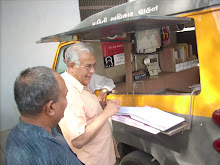The Hindu; Tuesday, Nov 02, 2010
MUMBAI: The Mumbai Collector had, in a letter to the Defence Estates Officer, Mumbai Circle, dated July 12, 2004, denied that the government of Maharashtra allotted any land to the Adarsh Cooperative Housing Society in Colaba.
Records obtained using the Right to Information (RTI) Act by the National Alliance of Peoples' Movements (NAPM), which were released on Monday by Ms. Medha Patkar, Simpreet Singh and other activists, show that the Collector accorded permission to the Adarsh Society on July 9, 2004.
Ms. Patkar, who produced both these letters and other documents to prove irregularities in Adarsh, said that the Collector was responding to a letter from the Defence Estates Officer, Mumbai Circle, Colaba, regarding a starred question in the Lok Sabha on December 10, 2003. However, the NAPM did not clarify why the information was given after the date of the answer.
The Collector at that time was Pradeep Vyas. His wife Seema Vyas, also an IAS officer, owns a flat in Adarsh. Attempts to reach Mr. Vyas on his mobile phone were futile.
Ms. Patkar said that even Parliament was being misled by the State government. She wanted first information reports (FIRs) to be filed against all the offenders, including the promoters of the Society, under the Prevention of Corruption Act and the Environment Protection Act.
 |
| Medha Patkar. |
Ms. Patkar said that P.V. Deshmukh, then Deputy Secretary, Urban Development Department, in a letter of March 15, 2003, to the Chief Engineer, Brihanmumbai Municipal Corporation, claimed that the Society did get a no objection certificate (NOC) from the Union Ministry of Environment and Forests (MoEF). “The Ministry of Environment and Forests have communicated their no objection to allowing the said residential development since it falls within the Coastal Regulation Zone (CRZ) - 2 area which satisfied the norms of notification dated 19 {+t} {+h} February 1991 and amendments made therein up to 21 {+s} {+t} May 2002. Now there appears therefore no objection to allowing residential development to the Adarsh Cooperative Housing Society on the land included in residential zone as per the modifications sanctioned by the government,” said Mr. Deshmukh. However, it was clarified by MoEF last week that no NOC was issued to the Adarsh Society. Mr. Deshmukh is a flat owner in Adarsh.
On August 19, 1999, Dr. S.V. Joshi, then principal secretary in the Urban Development Department, wrote to the MoEF asking for an NOC for Adarsh. The letter mentions that “the members of the Society are officers from the defence services who have dedicated their lives to the service of Motherland and deserve all special consideration and several members of the Society are even today fighting at Kargil and surrounding areas. It is requested that considering the above mentioned facts, the NOC for development of land under reference may be considered as a special case.”
The NAPM, which had complained to the Maharashtra Coastal Zone Management Authority on August 29, 2008 demanding action against Adarsh for violating environmental norms, has issued a letter to the authority before its meeting on November 3. It has demanded that Adarsh building be declared illegal and under the Environment Protection Act, the guilty officials and politicians and promoters prosecuted for illegal construction in a CRZ area.
Lavasa project
Suniti S.R. of the NAPM pointed out that P.V. Deshmukh later became Collector of Pune and gave permissions for the Lavasa project lands. Revenue Minister Narayan Rane last month admitted irregularities in the land acquired by Lavasa but all of them could be rectified by levying heavy fines under various laws.
In 2001, Lavasa was notified as a hill station of 25,000 acres, of which 12,316 acres was bought by the Corporation. About 141.15 hectares from the Krishna Valley Development Corporation was given to Lavasa on a 30-year lease without government permission and this is one of the issues that will be regularised. Some 609 hectares of surplus land under the Maharashtra Agricultural Lands (Ceiling on Holdings) Act, 1961 was bought by Lavasa unlawfully. It also bought 292 hectares of adivasi land, violating the Maharashtra Land Revenue Code which prohibits sale of such land.
Mr. Rane said that while the District Collector allowed the sale, he did not seek permission from the government, which is mandatory. Of the 292 hectares, about 102 hectares was legal. The rest had to be regularised.
Mr. Rane had given a month's time for the present Collector to submit reports on all these aspects. He also averred that action would be taken against the then Collector who had permitted these transactions without proper permissions. These irregularities that were detected by the Revenue Department could be rectified with retrospective effect.
He declined to comment on the size of the fine the company would have to pay to regularise the project. He said the Maharashtra Land Revenue Code, the Land Acquisition Act and other laws related to revenue and land would be adequate to impose a fine to rectify the irregularities.














































































